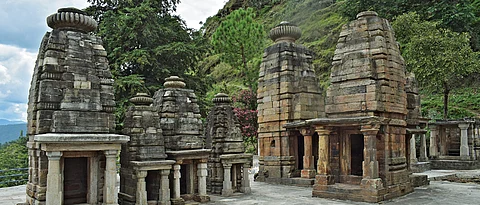

A short trek from the road, literally straight up a steep incline to the top of a hill leads to the Katarmal Sun Temple. A 9th century temple that lies in ruins today but still retains vestiges of its past grandeur. The temple stands atop a hill and commands a spectacular view of the lush green valley below. Today it stands silent, in imperial magnificence with not many visitors thronging its steps. The temple is one of the handful of sun temples that are found in India including the more famous temples of Konark in Odisha and Modhera in Gujarat.
The sun was viewed as a great benefactor, the light of life itself and the awe he inspired found shape in the temples that were built for his worship across the world. In India, the sun was worshipped as Surya, an important deity of the Hindu pantheon. These sun temples were more than temples and even today stand as an expression of the artistic and engineering genius of their builders. The Sun Temple of Katarmal is of the same pedigree and is unique in many respects.
A TIMELESS REMINDER OF HISTORY
The Katyuri kings ruled the region of what we now know as Uttarakhand. In fact, their reign extended from Nepal to Afghanistan. They ruled from the region known as Kumaon today from 9th century to 12th century. They are credited with building many temples across their kingdom, including the Katarmal Sun Temple, the Shiva Temple at Baijnath as well as the famous Vasu Dev Temple in Joshimath.
The Katarmal Sun Temple is said to have been built by a relatively obscure king of the Katyuri dynasty by the name of Katarmalla, sometime in the 9th century. Today, the sombre grey stones of the temple flanked by the bright red flush of bougainvillea flowers near the entrance presents a hauntingly beautiful picture, but of course, a ghost of its past glory.
THE ERODING BEAUTY OF KATARMAL
The Sun Temple of Katarmal lies in ruins today with much of its beauty eroded by the ravages of time and nature. The original temple consisted of a main shrine that was dedicated to Surya or Sun God in the form of Burhadita or Vraddhaditya which translates as ‘elderly or old sun’. The main shrine was flanked by 44 exquisite miniature temples. These smaller temples were dedicated to the various gods and goddesses like Shiva, Parvati, Vishnu, Lakshmi etc. The temple is now under the protection of the Archaeological Survey of India and is declared as a ‘protected monument’ under the Ancient Monuments and Archaeological Sites and Remains Act, 1958. However, it is sad to note that the original image of the Sun God that dated back to the 10th century was stolen and as a precaution against further vandalism the beautifully carved wooden doors and panels of the temple now woo visitors at the National Museum in Delhi.
The small temples that surround the main shrine are a visual delight. Carvings and sculptures around the temple, the pillars and the woodwork are a tribute to the skill of the artists of an era that has now passed into history. To see the exquisitely carved wooden doors and pillars one must head to the National Museum in Delhi. The temple complex has many damaged parts of the structure that include strange looking circular gear shaped structures that could be a representation of the sun.
The Katarmal Sun Temple nestled at more than 2,000 metres above sea level and framed by the Himalayan ranges has an aura of peace and tranquillity that is rare. As the rays of the sun shimmer down on you, your gaze moves towards the sanctum sanctorum where down the passage of history, men, women, and children must have congregated in worship. The valley must have then reverberated with Vedic chanting and come alive to the resonance of the temple drums and bells. Today, the only sound that you can hear at the Katarmal Sun Temple is the rustle of the wind that seems to whisper the symphony of stones that the temple was a long forgotten chapter of Indian history.
(Couple Sandy and Vyjay are travel bloggers — imvoyager.com, writers and social media influencers)
QUICK FACTS
- The Katarmal Sun Temple is located about 19 kilometres from the town of Almora in Uttarakhand.
- There is no worship in the temple and it is looked after by a caretaker appointed by the ASI.
- Reaching the temple involves a small trek that is fairly easy.
- The nearest airport to Katarmal Sun Temple is Pantnagar at a distance of about 135 kilometres.
